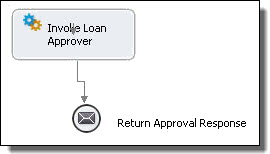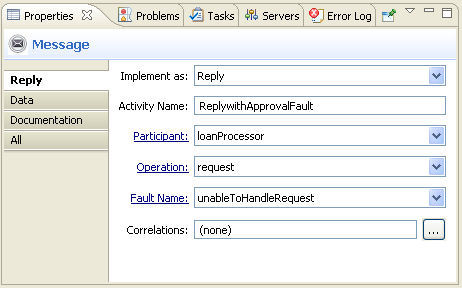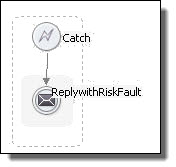Reply
BPMN Implementation: Send task, Message throw event
A reply activity sends a message back to a Web service in response to a message received or through fault handling. The received message is in a receive activity, an onMessage handler, an onEvent handler, or an invoke. For a request-response operation, a reply activity has the same partner link and operation as its matching receive, onMessage, or onEvent.
A receive may have multiple reply activities referencing it but only one of them is allowed to execute. For example, there may be a normal reply and a fault-handling reply. Both replies share a partner link and operation with receive, but only one of them is allowed to execute.
For an executable process, a reply activity must specify a variable for the message data being sent.
A reply activity can return a fault response. You can select a reply to handle a fault by adding it to a catch container and specifying the fault name and variable properties. See Adding a Fault Handler for more information.
A reply activity can return a fault response. You can select a reply to handle a fault by adding it to a catch container and specifying the fault name and variable properties.
Required Properties | Optional Properties |
|---|
Participant (Partner Link) | Name. See Selecting Activity Labels |
Operation | Port Type |
Variable See Input Variable or toPart fromVariable See From Variable to Part. | Correlation |
| Fault Name |
| Join Condition. See Creating a Join Condition for an Incoming Link |
| Suppress Join Failure. See Process Properties |
| Comment. See Adding Comments to a Process |
| Documentation. Adding Documentation to a Process |
| Setting Visual Properties and Using Your Own Library of Images |
| Execution State. See Viewing the Execution State of an Activity or Link |
| Message Exchange. See Message Exchange Declaration |
| Extension Attributes and Extension Elements. See Declaring Extension Elements and Attributes. |
To add a reply activity to the process manually:
For a shortcut and recommended technique, see Creating an Activity by Starting with a WSDL Interface.
- 1. Drag a Send task or Message throw event to the Process Editor canvas.
You can add a background color to the send task, but not the message throw event.
- 2. In the Properties view, select the following values:
- a. Optionally type in a Name.
- b. In the Participant drop-down, select New Process Service Consumer. See Creating a New Process Service Consumer Interface.
- c. Select an Operation from the picklist.
- 3. In the Data tab, do one of the following:
- - Select Single Variable from the Assignment Type and select a variable, or select New Variable.
- - Select XPaths or XQuery. For details, see Input Variable and From Part to Variable.
- 4. Select other optional properties as desired.
A simple example of using a reply activity in a process is shown in the following illustration.
To add a reply activity with a fault response:
- 1. Create a catch container for the appropriate scope or the process as a whole. For more information, see Defining Catch and CatchAll Fault Handlers.
- 2. Create a catch container for the appropriate scope or the process as a whole.
- 3. Add a reply to the catch container.
- 4. Select the properties and name, as described in the procedure above.
- 5. Select a Fault Name from the list. The fault name is defined in a WSDL file.
- 6. Select the fault variable from the Variable list.
The following illustration shows an example of a reply with fault. The fault name is shown in the main tab. The variable is specified in the Data tab.
The following illustration shows a simple example of using a reply with a fault in a catch handler.
XML Syntax
<reply partnerLink="NCName" portType="QName"?
operation="NCName"
variable="BPELVariableName"? faultName="QName"?
messageExchange="NCName"?
standard-attributes>
standard-elements
<correlations>?
<correlation set="NCName" initiate="yes|join|no"?>+
</correlations>
<toParts>?
<toPart part="NCName" fromVariable="BPELVariableName"/>+
<toParts>
</reply>
Example 1 Normal Response:
<reply name="reply" partnerLink="customer"
portType="lns:loanServicePT" operation="request"
variable="approval">
Example 2 Fault Handling:
<reply name="reply" partnerLink="customer"
portType="lns:loanServicePT" operation="request"
variable="error" faultName="unableToHandleRequest">



